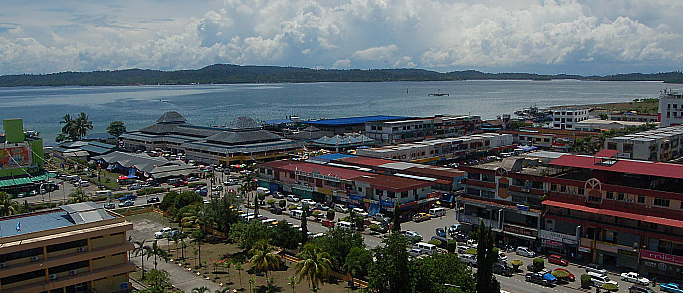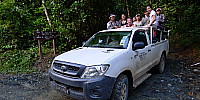Welcome in Lahad Datu. This small town at the East-coast of Sabah, has an estimated population of 200.000 persons. Lahad Datu has a small airport with daily flights to and from Kota Kinabalu. Lahad Datu is surrounded by stretches of cocoa and oil palm plantations. It is also an important timber exporting port.
For tourists, Lahad Datu is the main gateway to Tabin Wildlife and Danum Valley. It is a 2,5 hours by taxi/bus to Sandakan, and also 2,5 hours to Semporna or Tawau.
Tabin Wildlife Refuge is a nature preserve. It was created in 1984 to preserve Sabah’s disappearing wild animals. Occupying a large part of the peninsula forming the northern headland of Darvel Bay, it is located 48 kilometers east of Lahad Datu. Tabin Wildlife Reserve (TWR or Tabin) comprises a rectangular area of approximately 122,539 ha. in the centre of the Dent Peninsula, north-east of Lahad Datu town, south of the lower reaches of the Segama River and north of the Silabukan Protection Forest Reserve. It can be reached via sealed and gravel roads from Lahad Datu in about 40 minutes. The reserve is covered with lowland dipterocarp forest.
Fauna: Tabin has been declared a Wildlife Reserve primarily on account of the large number of animals inhabiting its forests, some of which are highly endangered. The three largest mammals of Sabah – the Borneo Elephant, Sumatran Rhinoceros and Tembadau (Bos javanicus), are all found within the reserve. The elephant population has been estimated to 120-300 animals in 1993. Other ungulate species include Sambar, Muntjac and Mouse Deer. In addition seven of Sabah´s eight primate species are present, among them Orang Utan and Proboscis Monkey. However, these two species occur in relatively low numbers in the reserve. The biggest predator in the reserve is the Sunda Clouded Leopard. There are also several other smaller carnivores in the reserve. Of bird species, 42 families representing 220 species have been recorded.
The land belongs to the people of Sabah. It is under government ownership and has Reserve status. The Sabah Wildlife Department is the custodian of the animals in the reserve. The Sabah Forestry Department is responsible for the trees in Tabin. In 1998, the Malaysian government privatized ecotourism programmes for Tabin and over the last few years increasing numbers of tourists have been coming to the reserve. Among activities permitted in the reserve are jungle trekking, wildlife viewing, photography and filming. Natural mud volcanoes are an important natural attraction for wildlife seeking salt, and these have become a bonus for visitors coming to see wild animals.
Danum Valley Conservation Area is a 438 square kilometres tract of relatively undisturbed lowland dipterocarp forest in Sabah, Malaysia. It has an extensive diversity of tropical flora and fauna, including such species as the rare Sumatran rhinoceros, orangutans, gibbons, mousedeer, clouded leopards and over 270 bird species. Activities offered are jungle treks, river swimming, bird watching, night jungle tours and excursions to nearby logging sites and timber mills.
The area holds unique status in the sense that before it became a conservation area there were no human settlements within the area, meaning that hunting, logging and other human interference was non existent making the area almost unique. It is managed by Yayasan Sabah for conservation, research, education, and habitat restoration training purposes.
The nearest town, Lahad Datu is about 82 km away (about a 2 hours drive on mainly logging roads). Danum Valley Field Centre is a research establishment for scientists and education purposes, and a nursery for propagating Dipterocarpus trees by the 100,000s. There is one lodge, the Borneo Rainforest Lodge, for tourists. From here visitors can do guided walks through lowland rainforest trails, and many people go there mainly for bird watching. Other activities include night walks and drives.
Fauna: The lowland tropical rainforest is home to many birds and mammals. It is the only place where the enigmatic Spectacled Flowerpecker has been recorded. Orangutans, Müller’s Bornean gibbons, and other primates, including Horsfield’s tarsier, as well as deer, wild cats and the rare Bornean Pygmy Elephant may be seen. Other notable species that inhabit the area are the Sun Bear and Sumatran Rhino.



